The U.S. Navy appears to be backing away from an extremely ambitious plan that emerged earlier this year to reach the goal of a fleet with 355 ships within the next 15 years. The service’s senior leadership has said that, unless their budget increases dramatically, they are looking at a fleet of between 305 and 310 ships in the near-to-mid-term. They say they will have also have to find a way to drive down the costs of buying and operating vessels, including focusing more on unmanned vessels, to realize real growth beyond the current 290-ship fleet after years of spending increasingly more on fewer ships.
Various Navy officials offered these remarks at the Military Reporters and Editors Conference on Oct. 25, 2019. The service had previously published its most recent Long-Range Plan for Construction of Naval Vessels in March 2019, which charted an aggressive and very costly course to reaching the long-standing and Congressionally-mandated objective of having a 355-ship fleet by 2034. The Navy has already said that this plan is likely to change when it publishes its next Force Structure Assessment, which it hopes to have ready by the end of the year. Its last Force Structure Assessment, published in 2016, had laid out a requirement for 355 ships, which Congress subsequently enshrined into law.
“Will we get to 355-ships?” U.S. Navy Admiral Robert Burke, the Vice Chief of Naval Operations, the service’s number two uniformed officer, said at the Military Reporters and Editors Conference. “I think with today’s fiscal situation, where the Navy’s top line is right now, we can keep around 305 to 310 ships whole, properly manned, properly maintained, properly equipped, and properly ready.”
This is a slightly lower projection than the one that the Navy included in its budget request for the 2020 Fiscal Year, which came out in February 2019 and set out a path reaching 314 ships in 2024. This is in line with the 2019 shipbuilding plan, which the service published a month later, envisioned hitting the 314 ship mark in the 2025 Fiscal Year, which begins on Oct. 1, 2024.

This is actually a slower pace than what the service had called for in its 2019 Fiscal Year budget proposal, which saw the service reaching 326 ships in 2023.
“If our [budget] top line does not go up, if it remains where it is now and is projected to remain in the future defense plans, that’s about where we can get to and do it right, in terms of man those ships and maintain them and have all the ordnance for them and generate readiness,” Burke said of his 305- to 310-ship fleet estimate. “We would need an increased top line” to get above that, he added.
Cost has clearly been a major driver in reassessing these shipbuilding timelines, as well as the increased questioning of the 355-ship goal, as a whole. “A 355-ship Navy is an important aspirational goal. … But more important is ensuring that we have the maximum capability to address every challenge we’re going to be facing,” Secretary of the Navy Richard Spencer had said at a separate gathering at the Brookings Institution think tank in Washington, D.C. last week.
These funding concerns were already readily apparent in the Navy’s 2019 shipbuilding plan, which said that it would cost the service $660 billion over the next 30 years to acquire the hulls necessary to reach the 355 ship mark and to sustain them going forward. That report projected that it would cost $40 billion annually to operate and maintain this many ships, a 30 percent increase over what it spends now.
Earlier in October 2019, the Congressional Budget Office (CBO) issued its own assessment of the Navy’s plan, questioning whether the service had adequately estimated the total price tag for this shipbuilding endeavor over the next three decades. CBO’s analysts said that the Navy’s plan could cost as much as $865 billion in total, primarily due to differences in shipbuilding cost estimates. Where the Navy said it would need to spend almost $22 billion just acquiring ships each year on average to arrive at a 355-ship fleet and sustain it through 2049, CBO’s metrics said this figure was likely to be closer to $29 billion.
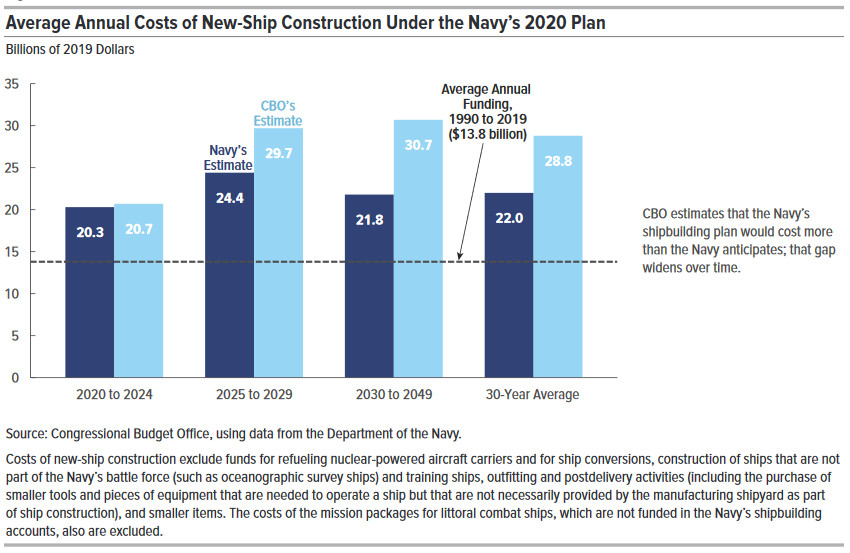
No matter how the costs are calculated, the Navy is certainly in agreement that the fleet it has today has only become increasingly more expensive in terms of ship unit prices and operational and maintenance costs. “Going back to the ‘80s, when we had the 600-ship Navy, the average cost of our ship in that fleet was a billion dollars, that was the average cost of all those ships,” Thomas Modly, the Undersecretary of the Navy, said at the Military Reporters and Editors Conference.
“Today, our current fleet of 290, the average cost is $2 billion. And that’s in real dollars, inflation-adjusted real dollars,” he continued. “So what that suggests is we’re piling a lot more capability and a lot more expense on a smaller number of platforms.”
This reality extends to operational and maintenance costs, as well, and is apparently reflected most in the ballooning price of what it takes to operate a complete carrier strike group. Carrier strike groups, previously known as carrier battle groups, accounted for around 14 percent of the Navy’s operations and maintenance budget 30 years ago, according to USNI News. Today, it’s just over 30 percent.
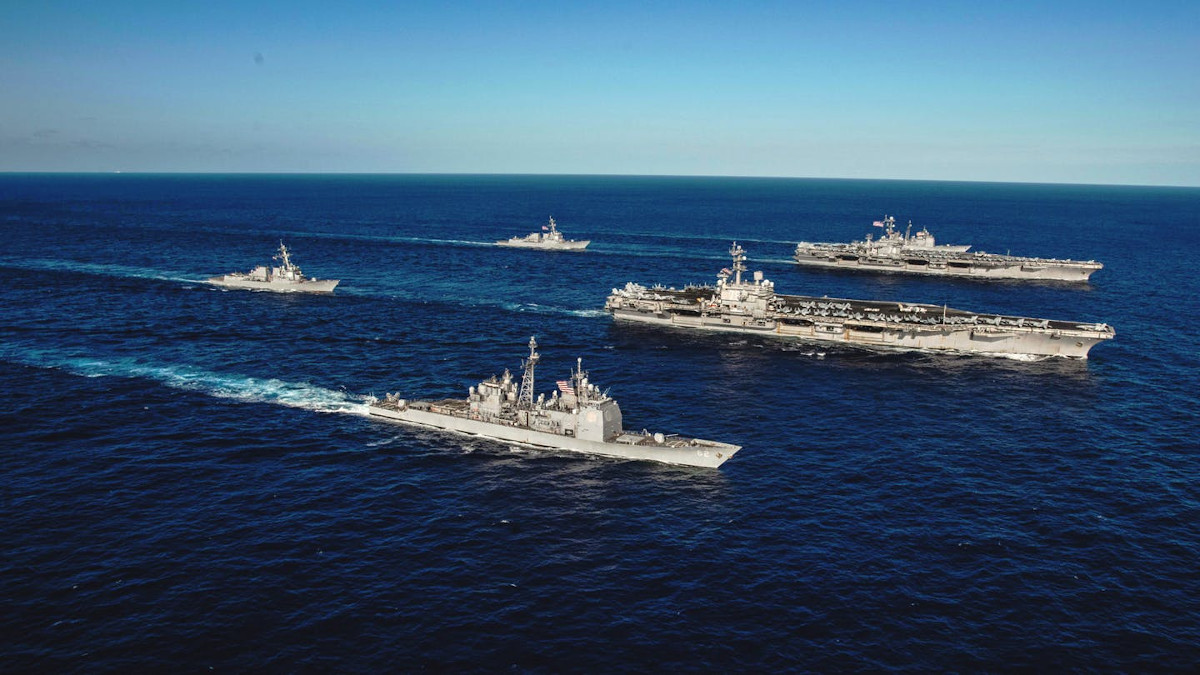
Costs associated with the troubled first-in-class USS Gerald R. Ford, as well as the next ships in that class, have steadily grown in recent years. The fourth ship in the class, a still-unnamed ship known by the hull number CVN-81, could cost as much as $15 billion to build by itself. This would be a full two percent of the Navy’s estimated ship-related costs over the next 30 years under the 2019 shipbuilding plan.
“Now, I’m not sure when we’re looking at a scenario where we’re dealing with a great power like China or Russia, where we’re going to have distributed responsibilities, whether that’s the right strategy for us,” Undersecretary Modly continued. “So we’re looking at that and examining that.”
By every indication the Navy, with the full support of the U.S. Marine Corps, is increasingly looking at potential lower-cost and more flexible shipbuilding options that result in ships better suited to the kind of distributed operations that will only become increasingly more likely to occur in future conflicts as time goes on. These are things The War Zone has covered in depth in the past, which you can read about more here and here.
These efforts already include, among other things, plans to acquire a new class of frigates, or FFG(X), which will be derived from an existing in-production design and will leverage as much existing technology as possible to try to keep costs down. The Navy is aiming for an average unit cost of around $800 million for these ships, which would be less than half the average unit cost of the ships the Navy has now, despite an impressive array of planned capabilities, which you can read about more in this past War Zone story.
The Navy also has ongoing efforts to try to improve the capabilities of the chronically underperforming Littoral Combat Ships (LCS) and plans to begin exploring new concepts of operations for those vessels, as well as others, such the Zumwalt class stealth destroyers, which will better reflect what they can and cannot actually do. These efforts have included the establishment of a new, dedicated surface warfare development unit, known as Surface Development Squadron 1, or SURDEVRON 1.
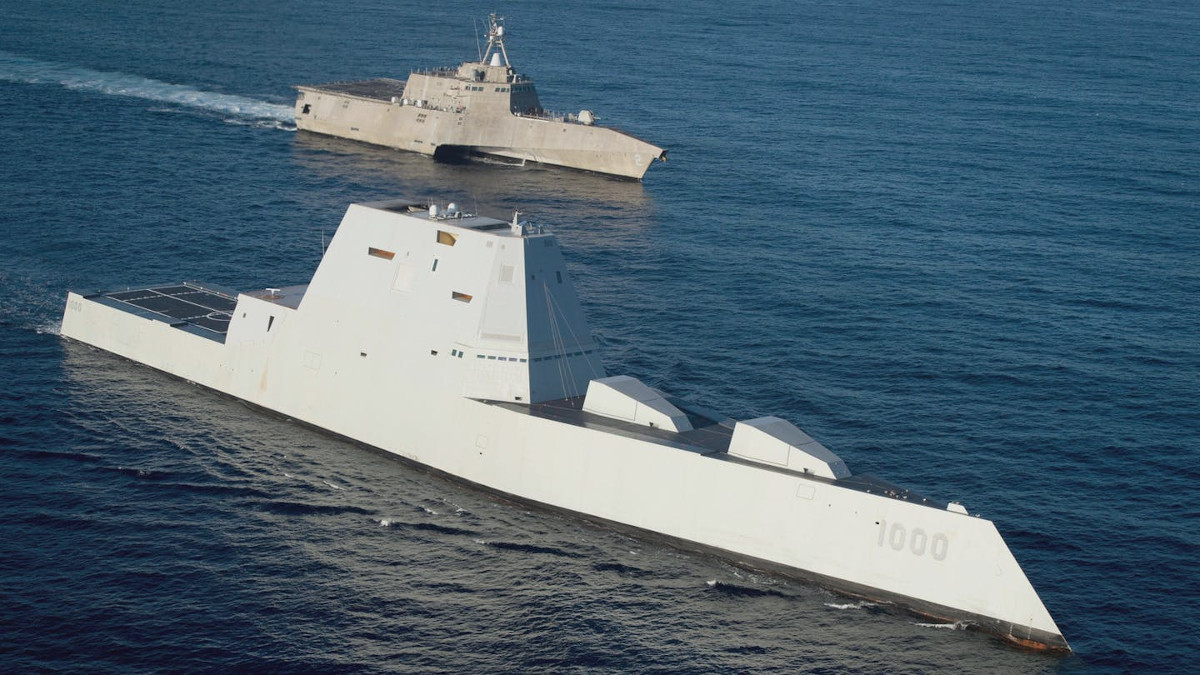
All three Zumwalts will eventually join SURDEVRON 1, together with the first two Littoral Combat Ships from both the Freedom and Independence subclasses, which have already been largely related to non-deployable test and training roles. The squadron, which you can read about in more detail in this past War Zone piece, will also eventually contain a number of experimental unmanned surface vessels.
The Navy is very actively embracing the potential benefits of unmanned surface and undersea vessels as a path to increasing the overall size of the service’s fleets, as well as their capabilities, while also keeping costs low. The Navy’s 2020 Fiscal Year budget proposal calls for acquiring up to 10 Large Displacement Unmanned Surface Vessels (LDUSV) over the next five years at a total cost of just around $2.7 billion. Each one of these would be a multi-purpose ship with a displacement of 2,000 tons, around the same size as modern manned corvettes.
On Oct. 1, 2019, the Navy announced the beginning of the second phase of the Ghost Fleet Overlord program, which will help inform the LDUSV program. The service has been conducting this effort in cooperation with the Office of the Secretary of Defense’s Strategic Capabilities Office (SCO). The SCO is leading a number of potentially revolutionary development efforts across the entire U.S. military.
The first phase of the Ghost Fleet Overlord program involved hiring two teams to each convert one commercial fast supply vessels, also referred to as offshore support vessels (OSV), into an unmanned surface vessel. Phase II, which is set to finish up in 2021, “will be conducted using the same ships from Phase I and will focus on the integration of government-furnished command-and-control systems and payloads and involve more complex and challenging naval experimentation,” according to the Navy. After this phase is complete, SCO will also turn over the ships to full Navy control for further experimentation.
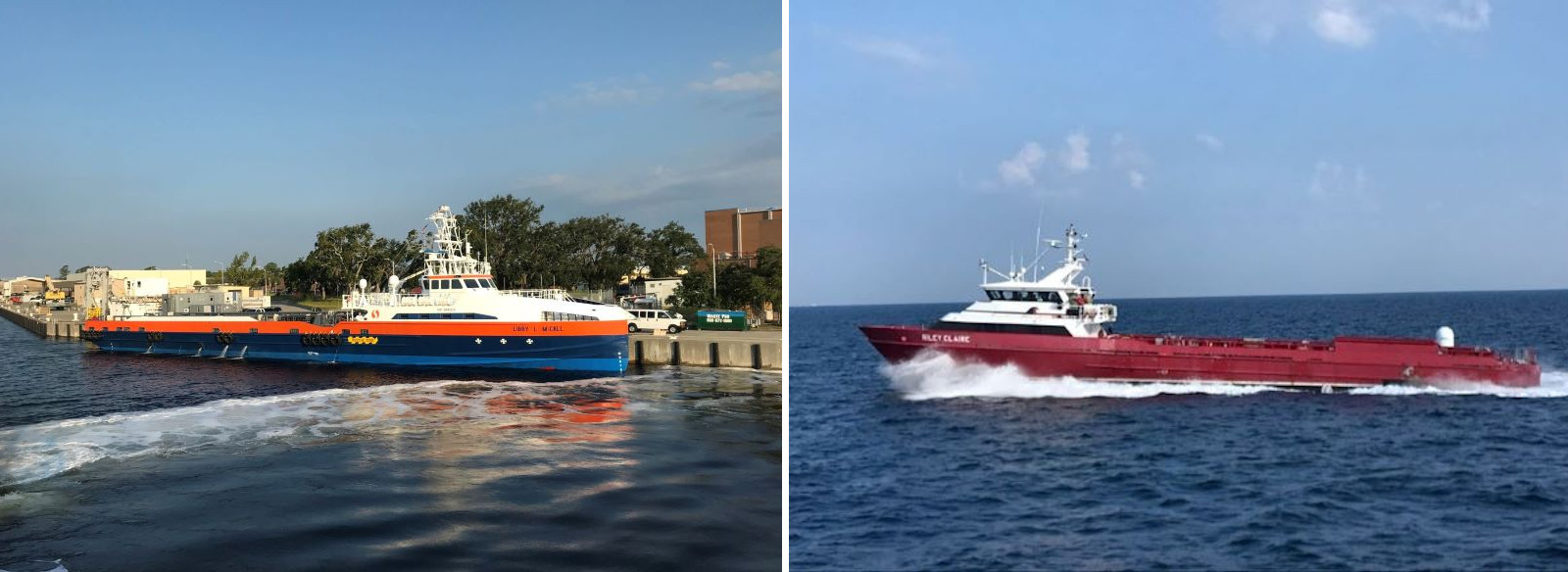
This is similar to the development of the Sea Hunter, a smaller unmanned surface vessel. The Defense Advanced Research Projects Agency (DARPA) initially led this project, before handing it over completely to the Navy last year. The service is now buying a second one of these crewless ships and will use them to support the development of a Medium Displacement Unmanned Surface Vessel (MDUSV). The first two Sea Hunters will join SURDEVRON 1 to help support the development of concepts of operations for these ships, including manned-unmanned teaming, as well.

You can read more about the LDUSV and MDUSV programs in these two past War Zone stories. The Navy is also working in small unmanned surface vessels, as well as expanding its unmanned undersea vehicles, to include large displacement drone submarines, developments that The War Zone has also been following closely.
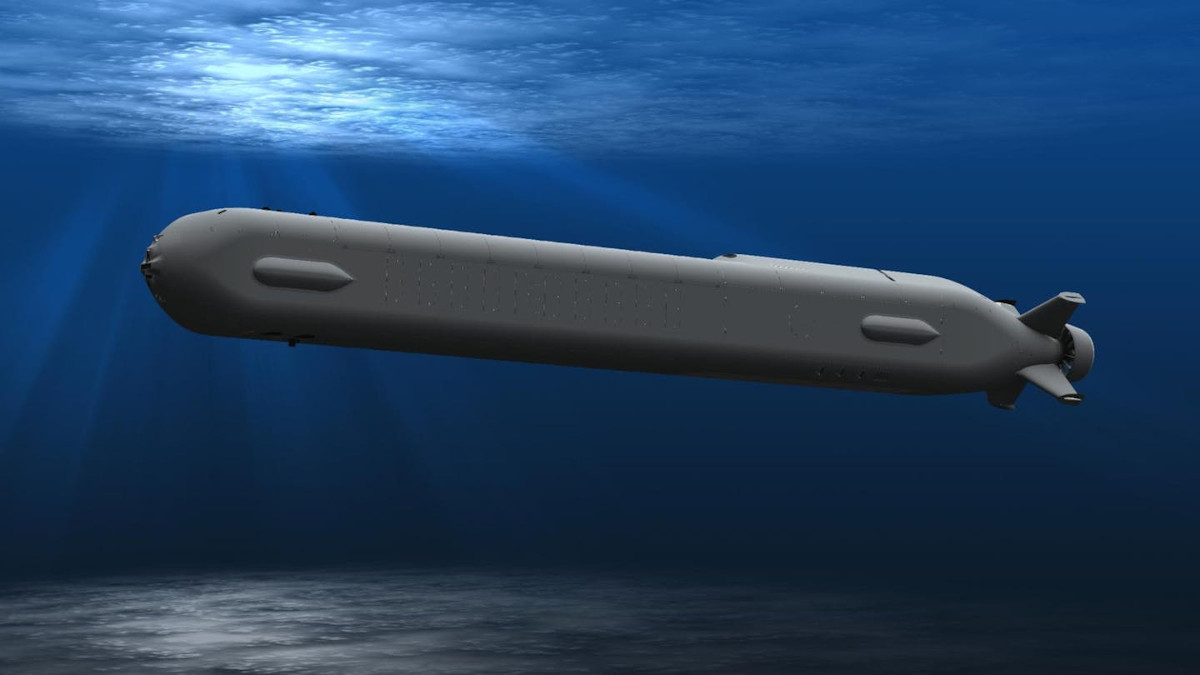
The upcoming Force Structure Assessment will almost certainly reflect this increasingly unmanned reality. It may even call for counting existing and future unmanned vessels within the service’s projections for its so-called “Battle Force,” which presently only includes manned surface vessels and submarines.
“If you look at what it would take to do that – and we laid this into our 30-year shipbuilding plan – it’s going to be very, very difficult for us to do that, A) based on that force structure, and B) based on the budget and top line,” Modly explained. “So we’re all sort of coming to this realization now that there’s a math problem that we need to try to solve, and we have to be creative about how we’re going to solve it.”
“First of all, is the number 355 the right number? I don’t know. I suspect it’s probably more, it probably needs to be more than that – but the way we define a battle force ship, we probably have to think about that differently, as well,” he continued. “As technology advances and we have the ability to have fairly large unmanned platforms out there that have significant lethality, do we include them in our ship force count? So we have to take a really hard look at what 355 means, if it’s the right number, does it even matter what the number is, and what are we investing in for the future.”
The Navy’s upcoming Force Structure Assessment, which will hopefully be public before the end of the year, will give the first real sense of how the Navy might envision its future fleet after years of spending increasingly more, but buying fewer ships. However, it seems increasingly likely that it won’t call for 355 ships and that the future battle force it describes will feature a much larger number of unmanned vessels.
Contact the author: joe@thedrive.com
